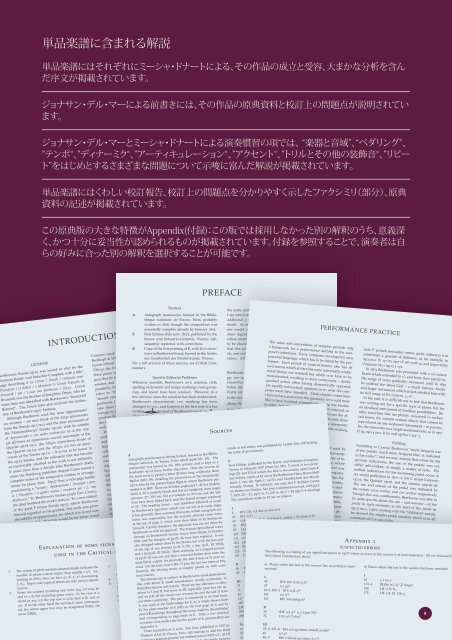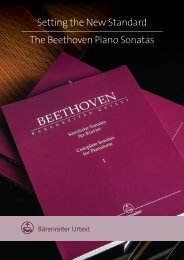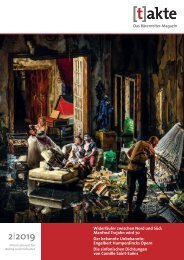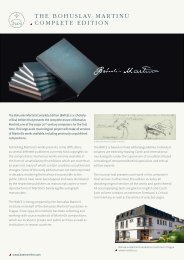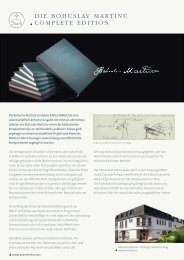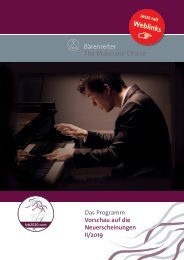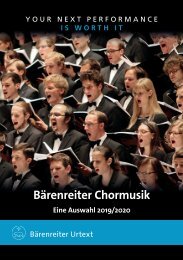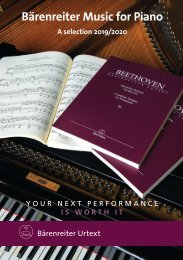Beethoven-Brochure_japanisch_12pp_web_NEU
You also want an ePaper? Increase the reach of your titles
YUMPU automatically turns print PDFs into web optimized ePapers that Google loves.
単 品 楽 譜 に 含 まれる 解 説<br />
単 品 楽 譜 にはそれぞれにミーシャ・ドナートによる、その 作 品 の 成 立 と 受 容 、 大 まかな 分 析 を 含 ん<br />
だ 序 文 が 掲 載 されています。<br />
ジョナサン・デル・マーによる 前 書 きには、その 作 品 の 原 典 資 料 と 校 訂 上 の 問 題 点 が 説 明 されてい<br />
ます。<br />
ジョナサン・デル・マーとミーシャ・ドナートによる 演 奏 慣 習 の 項 では、“ 楽 器 と 音 域 ”、“ペダリング”、<br />
” テ ン ポ “ 、” ディナ ーミク “ 、” ア ー ティキュレ ー ション “ 、” アク セ ント “ 、”トリルと そ の 他 の 装 飾 音 “ 、”リピ ー<br />
ト”をはじめとするさまざまな 問 題 について 示 唆 に 富 んだ 解 説 が 掲 載 されています。<br />
単 品 楽 譜 にはくわしい 校 訂 報 告 、 校 訂 上 の 問 題 点 を 分 かりやすく 示 したファクシミリ( 部 分 )、 原 典<br />
資 料 の 記 述 が 掲 載 されています。<br />
この 原 典 版 の 大 きな 特 徴 がAppendix( 付 録 ):この 版 では 採 用 しなかった 別 の 解 釈 のうち、 意 義 深<br />
く、かつ 十 分 に 妥 当 性 が 認 められるものが 掲 載 されています。 付 録 を 参 照 することで、 演 奏 者 は 自<br />
らの 好 みに 合 った 別 の 解 釈 を 選 択 することが 可 能 です。<br />
PREFACE<br />
GENESIS<br />
INTRODUCTION<br />
eethoven’s Sonata op. was issued in by the<br />
iennese Kunst- und Industrie-Comptoir, with a titleage<br />
describing it as LIVme / Sonate / composée pour<br />
Pianoforte / et dédiée / à Monsieur le Comte François de<br />
Brunsvik / par / Louis van <strong>Beethoven</strong> / Op.. Count<br />
Brunsvik was the brother of Josephine Deym, who for<br />
some time was identified with <strong>Beethoven</strong>’s “Immortal<br />
Beloved”. The Count later also received the dedication<br />
of <strong>Beethoven</strong>’s op. Fantasie.<br />
Although <strong>Beethoven</strong> used the term ‘appassionato’<br />
on occasion – we may think of the Largo appassionato<br />
from the Sonata op. no. and the slow movement of<br />
the ‘Hammerklavier’ Sonata op., with its subtitle<br />
of Appassionato e con molto sentimento; or of the Adagio<br />
affettuoso ed appassionato second movement of the<br />
Quartet op. no., the Allegro appassionato finale of<br />
the Quartet op. and the Allegro con brio ed appassionato<br />
of the Sonata op. – it is not to be found in<br />
the op. Sonata, and the nickname that has become<br />
so inextricably attached to the work is not authentic.<br />
It arose more than a decade after <strong>Beethoven</strong>’s death,<br />
when the Hamburg publisher August Cranz issued a<br />
complete series of the composer’s sonatas in arrangements<br />
for piano duet. Op. bore a title-page boldly<br />
proclaiming a “Sonata / Appassionata / Arrangée / pour<br />
le / Pianoforte / à quatre mains / composée par / L. van<br />
<strong>Beethoven</strong>.” To <strong>Beethoven</strong>’s former pupil Carl Czerny,<br />
the label belittled the work’s stature: “In a new edition<br />
of the great F minor Sonata op., which <strong>Beethoven</strong><br />
himself regarded as his greatest, this work was given<br />
the subtitle of appassionata, for which it is in any case<br />
far too splendid. This title would be far better suited<br />
to the E flat Sonata op., which he wrote in a very<br />
passionate mood.” 1<br />
The op. sonata was composed between the summer<br />
of and the early months of , during what<br />
was one of the richest creative periods of <strong>Beethoven</strong>’s<br />
life. He had recently completed the ‘Waldstein’ Sonata<br />
op. and the F major Sonata op., as well as the Triple<br />
Concerto op.. In addition, he was hard at work<br />
on his opera Leonore, and was about to embark on the<br />
‘Razumovsky’ quartets op. and the Fourth Piano<br />
1. The system of pitch notation adopted simply indicates the<br />
number of whole octaves higher than middle c (c 0 ). Ascending<br />
in fifths, then, we have g 0 , d 1 , a 1 , e 2 ; descending,<br />
f 1 , b 2 . Upper case (capital) letters are only used to denote<br />
sources.<br />
2. Notes are counted including tied notes (e.g. n.2 may be<br />
tied to n.3), but excluding grace notes. In the case of a<br />
chord at, say, n.3, the top note is n.3a, then n.3b, and so<br />
on. If on the other hand the writing is more contrapuntal,<br />
the entire upper line may be designated RH(a), the<br />
lower RH(b).<br />
1 Carl Czerny: “Anekdoten und Notizen über <strong>Beethoven</strong>”, Über<br />
den richtigen Vortrag der Sämtlichen <strong>Beethoven</strong>’schen Klavierwerke, ed.<br />
Paul Badura-Skoda (Vienna, ), p..<br />
A<br />
E<br />
Sources<br />
Autograph manuscript, housed in the Bibliothèque<br />
nationale de France, Paris; probably<br />
written in , though the composition was<br />
essentially complete already by January .<br />
First Edition (February ), published by the<br />
Kunst- und Industrie-Comptoir, Vienna; subsequently<br />
reprinted with corrections.<br />
K Copy of the first printing of E, with five corrections<br />
in <strong>Beethoven</strong>’s hand, housed in the Archiv<br />
der Gesellschaft der Musikfreunde, Vienna.<br />
For a full account of these sources, see Critical Commentary.<br />
Concerto op., among other works. From a letter to<br />
Breitkopf & Härtel of August , in which <strong>Beethoven</strong><br />
offered the publishers his oratorio Christus am<br />
Ölberge, the Eroica Symphony, the Triple Concerto and<br />
three piano sonatas (opp., and ), it would appear<br />
that he had not yet begun work on the last of the<br />
sonatas, and was even turning over in his mind the<br />
possibility that it could be a chamber piece. <strong>Beethoven</strong><br />
refers to “three new solo sonatas”, and continues:<br />
“should you wish to have one of these with accompaniment,<br />
I would consider it – if you would like to<br />
take these things now, you would have to be good<br />
enough to indicate to me exactly the time you need to<br />
produce them, since it is my greatest wish that at least<br />
the three first works [i.e. the oratorio, the symphony<br />
and the concerto] should appear as soon as possible.” 2<br />
Work on the op. Sonata must have progressed<br />
swiftly, because a reminiscence by <strong>Beethoven</strong>’s pupil<br />
and early biographer Ferdinand Ries of how the work’s<br />
finale, with its constant semiquaver ( th -note) motion,<br />
came into being probably dates from the same summer<br />
of : “During a similar walk when we lost<br />
our way so badly that we only got back to Döbling,<br />
where <strong>Beethoven</strong> was living, at eight o’clock, he had<br />
hummed the entire way, or sometimes howled, to himself<br />
– continually up and down, without singing any<br />
definite notes. When I asked what this was, he said: ‘A<br />
theme for the last Allegro of the sonata has occurred<br />
to me’ (in F minor, opus ). When we entered the<br />
room he rushed to the piano without taking off his<br />
hat. I sat down in a corner, and he soon forgot about<br />
me. Now he stormed on for at least an hour with the<br />
new finale of this sonata, which is so beautiful as it<br />
stands. Finally he got up, was surprised to see me<br />
still there, and said, ‘I cannot give you a lesson today.<br />
I have work to do.’” 3<br />
In the end, <strong>Beethoven</strong> failed to reach a financial<br />
agreement with Breitkopf & Härtel, and of the works<br />
he had offered to them at this time they took only<br />
Christus am Ölberge – which, however, did not appear<br />
until .<br />
E <br />
C C<br />
Specific Editorial Problems<br />
Wherever possible, <strong>Beethoven</strong>’s own notation, clefs,<br />
spelling of dynamic and tempo markings, note-groupings,<br />
and layout have been retained. However, in a<br />
few obvious cases the notation has been modernized:<br />
<strong>Beethoven</strong>’s characteristic cres. marking has been<br />
changed to cresc., and hairpins to the first note of a bar<br />
œ<br />
written instead of <strong>Beethoven</strong>’s usual œ .<br />
Then both A and E often retain the old convention<br />
whereby in a / movement, half-bar rests and notes,<br />
and whole-bar notes, may be written , , respectively<br />
(cf. the modern for a bar’s rest of any length);<br />
these have obviously been changed to . , . and ..<br />
Abbreviated forms such as . (in I) and (in II) occur<br />
frequently in both sources; in slow music such as II /<br />
the notes are clearly best written out in full. In I there<br />
could have been a case for retaining the original abbreviations,<br />
highly characteristic of <strong>Beethoven</strong> as they<br />
are, but they have nevertheless (reluctantly, it must<br />
be confessed) been eschewed on practical grounds.<br />
Editorial insertions and emendations are distinguished<br />
by the use of either square brackets or (in<br />
the case of slurs) by broken type.<br />
A<br />
Autograph manuscript in oblong format, housed in the Bibliothèque<br />
nationale de France, Paris (shelf mark Ms. 20). The<br />
manuscript was bound in the 19th century and is kept in a<br />
handsome set of three leather slip-cases. Onto the reverse of<br />
the front cover is pasted a letter 20 lines long, written by René<br />
Baillot (1813–89), detailing the provenance of the manuscript,<br />
left to him by the pianist Marie Bigot to whom <strong>Beethoven</strong> presented<br />
it in 1807. There are 22 folios, paginated 1–42 in a modern<br />
hand (f. 22 is entirely blank and has no numbers); most pages<br />
measure 22×30½cm, but p.5 extends to 31½cm and the last<br />
3cm have been folded back (and the frayed margin repaired)<br />
to fit. The heading Sonata – was doubtless followed as usual<br />
by <strong>Beethoven</strong>’s signature, which was cut out at an early stage;<br />
it has generally been assumed that some selfish autograph collector<br />
was responsible, but the excision affected some notes<br />
at the top of page 2, which were then filled in by <strong>Beethoven</strong><br />
himself. Clearly, therefore, the signature was cut out either by<br />
<strong>Beethoven</strong> or with his approval. The manuscript suffered water<br />
damage on <strong>Beethoven</strong>’s stormy return from Silesia in October<br />
1806, and the margins of pp.29–44 were later replaced. It was<br />
also chopped rather close by the binder, but with the loss only<br />
of the top of one fermata (p.25, II 97), a slur (p.31, III 135/6),<br />
and a tie (p.42, III 341/2). More seriously, an L-shaped portion<br />
of pp.19–20 was cut out; here a souvenir-hunter does seem the<br />
most likely culprit, for precisely the first 8 bars of II were excised.<br />
On the recto were I 249–51 plus the last two notes of 254;<br />
Dynamics<br />
It is an occasional feature of <strong>Beethoven</strong>’s notation that<br />
he treats the two hands of the piano as separate entities,<br />
giving a dynamic marking to one or other, or<br />
both. Where <strong>Beethoven</strong> appears to intend a dynamic<br />
to apply to just one hand, we have reproduced this<br />
precisely, as is of course crucial in respect of sf or sfp<br />
markings. But it is sometimes harder to justify where<br />
the same dynamic is given to both hands at precisely<br />
2 Ludwig van <strong>Beethoven</strong>: Briefwechsel. Gesamtausgabe, ed. Sieghard<br />
Brandenburg, vol. (Munich, ), pp.–.<br />
3 Franz Gerhard Wegeler and Ferdinand Ries: Biographische Notizen<br />
über Ludwig van <strong>Beethoven</strong> (Koblenz, ), p..<br />
3. Vers.I indicates an original version, subsequently revised.<br />
Vers.II may then signify either the final version, or an intermediate<br />
one later altered to the final version (Vers.III).<br />
4. LvB = in <strong>Beethoven</strong>’s handwriting.<br />
5. 81–4 = 81 to (through) 84<br />
81/4 = 81 and 84<br />
Therefore: 95–6 = both 95 and 96<br />
But: 95/6 = one marking (e.g. a slur) that starts in 95 and<br />
finishes in 96.<br />
III<br />
S<br />
the same point. It may assist clarity, for example in<br />
I which starts with differentiated dynamics, so the<br />
additional p dimin. below LH removes any lingering<br />
doubt. In especially emphatic places such as I /<br />
one would not wish in any way to detract from the<br />
sheer degree of drama in <strong>Beethoven</strong>’s dynamics. But<br />
where merely a general dynamic such as pp happens<br />
to be placed in both staves, we can honestly judge<br />
that this adds nothing even psychological to the music,<br />
and reduce it to one simple marking between the<br />
staves. All such instances are given in Appendix .<br />
Punkte and Striche<br />
<strong>Beethoven</strong> was said (cf. Nottebohm, <strong>Beethoven</strong>iana (),<br />
pp. –) to be punctilious about the difference between<br />
Punkte and Striche (dots and dashes), and Nottebohm<br />
cites two essential pieces of evidence for this:<br />
firstly (on pp. –) <strong>Beethoven</strong>’s copious corrections<br />
to the first performance parts of the Allegretto of Symphony<br />
No. , op. , viz: œ œ '<br />
œ '<br />
œ .<br />
œ . (etc.), secondly a<br />
letter of August to Karl Holz (Emily Anderson,<br />
The Letters of <strong>Beethoven</strong> (), No.) in which<br />
<strong>Beethoven</strong> gives the firm instruction that “ œ '<br />
œ '<br />
œ ' and<br />
œ . œ . œ . are not identical”. But the whole point about<br />
both these is that <strong>Beethoven</strong>’s requests are absolutely<br />
consistent: his staccato signs should always be given<br />
as Striche, unless they are beneath slurs, in which case<br />
this is portato and they should of course be Punkte.<br />
This principle is entirely without problem or necessity<br />
for any exceptions, and we have adhered strictly to it.<br />
Acknowledgements<br />
The staffs of the Bibliothèque nationale de France and<br />
the Archiv der Gesellschaft der Musikfreunde, Vienna<br />
have been consistently willing and helpful, and I thank<br />
them for their kindness and patience. I am grateful,<br />
too, to all the various libraries which kindly supplied<br />
copies of E for comparison. Then I have received advice<br />
from many distinguished pianists, especially Paul<br />
Badura-Skoda, Oliver Davies, Leslie Howard, Julian<br />
Jacobson, Robert Levin, John Lill and Mitsuko Uchida,<br />
and I thank them warmly for their valuable insights<br />
which assisted greatly in the determination of the<br />
most faithful, and at the same time plausible, text.<br />
VI<br />
The rules and conventions of notation provide only<br />
a framework for a performance faithful to the composer’s<br />
intentions. Every composer develops his own<br />
personal language, which has to be learnt by the performer.<br />
Each period of musical history also has its<br />
own norms which at the time were universally understood<br />
(hence not notated) but which now have to be<br />
reconstructed, resulting in keen controversy – distinguished<br />
artists often having diametrically opposed,<br />
yet equally entrenched, opinions as to what the composer<br />
must have intended. Musicologists sometimes<br />
claim to have answers to the questions we would most<br />
like to have resolved, triumphantly citing one treatise<br />
or other, but often some evidence (usually internal, in<br />
the music itself) crops up which then throws the alleged<br />
rule into doubt. In such cases we can only draw<br />
attention to the various issues, so that the interpreter<br />
at least gives them some consideration before making<br />
his own artistic decisions.<br />
Instruments and range<br />
To a certain extent, to perform a keyboard work by<br />
<strong>Beethoven</strong> on a modern piano is to play a transcription<br />
of music conceived for a very different type of instrument.<br />
It was one whose touch was lighter, whose<br />
attack was cleaner, and whose sustaining power was<br />
considerably weaker, especially in the upper register.<br />
The hammers were covered in leather rather than the<br />
felt of modern instruments, and the frame was wooden,<br />
not metal. In addition, the dip of the keys was shallower,<br />
making such effects as the glissandi in octaves<br />
in the coda of the ‘Waldstein’ Sonata, so problematic<br />
to the performer on a modern piano, perfectly feasible.<br />
During <strong>Beethoven</strong>’s lifetime the piano underwent<br />
continual development, partly as a result of the demands<br />
he placed on it, though he seems never to have<br />
been entirely happy with the instruments he experienced.<br />
One area of particular frustration with his earlier<br />
pianos was their restricted -octave range, from<br />
f to f 2 , that had been in use ever since the days of<br />
Haydn and Mozart. While Mozart’s keyboard music<br />
seldom imparts the impression that the range is a<br />
compositional hindrance, that is by no means the case<br />
with <strong>Beethoven</strong>, who is constantly straining against<br />
the limitations, particularly at the upper end. It is<br />
important for the player on a modern instrument to<br />
realise that in <strong>Beethoven</strong>’s earlier piano works, the top<br />
bizarrely, the missing music is roughly pasted in, with crass<br />
inaccuracies.<br />
The manuscript is written in <strong>Beethoven</strong>’s usual dark-brown<br />
ink, with about 20 small emendations, mostly accidentals, in<br />
Rötel (his famous red crayon). There are few deletions or alterations<br />
in I and II, but more in III, especially from bar 141 on,<br />
and on p.41 all the music was crossed out and the last 21 bars<br />
rewritten completely. The piece is essentially in its final form;<br />
A was used as the Stichvorlage for E, as is amply shown both<br />
by the plate number of E (521) on the first page of A and by<br />
pencil X markings throughout the score, made by the publisher<br />
and corresponding to page-ends in E. Only a few material<br />
revisions were made later (in the proofs of E, presumably); see<br />
Appendix 3.<br />
Three facsimiles of A exist. The first, published in 1927 by<br />
l’Édition d’Art H. Piazza, Paris, did manage to add the Rötel<br />
eparate process, but omitted some (I 4 RH n.2 , 29 LH<br />
processsimile<br />
in full colour was published by Laaber (but still lacking<br />
the letter of provenance).<br />
E<br />
First Edition, published by the Kunst- und Industrie-Comptoir,<br />
Vienna in February 1807 (Plate No. 521). E exists in two printings<br />
(E1 and E2) of which the first is the scarcer; apart from K<br />
(see below), copies of E1 are at the <strong>Beethoven</strong>-Haus, Bonn (shelf<br />
mark J. van der Spek C op.57) and Gesellschaft der Musikfreunde,<br />
Vienna. In addition, one copy (Ira F. Brilliant Center<br />
for <strong>Beethoven</strong> Studies, San José, California) is mixed, with pp.2,<br />
7, 10/8–20 = E1, pp.5–6, 11–2/5–6, 22–3 = E2 (pp.3–4 missing).<br />
The corrections made in E2 are as follows:<br />
I<br />
4 RH, LH: n.2 slur to end of 6<br />
23 RH: n.3 <br />
60 LH: dot to n.1b f 1 ; 2nd beat f 1 added, + tie from n.1b<br />
92 RH: n.1–2 tie<br />
93 LH n.1b <br />
103 RH: n.2 to c (not d)<br />
132 n.1 <br />
204 LH: n.3–4 tie<br />
223 RH: n.1 a (not b)<br />
228 LH (end of bar): <br />
231 LH: ped.<br />
II<br />
60 RH: n.2 <br />
78 LH: n.2 16th beam<br />
III<br />
73 RH: n.4 <br />
76 RH: n.1 <br />
80 RH: n.1 <br />
127 LH(b): slur to 128 removed<br />
145 RH: n.2 c (not b)<br />
238 RH: n.2 <br />
284 RH: n.2 c (not d)<br />
288 n.1 f<br />
Jonathan Del Mar<br />
However, an even greater quantity of mistakes (including wrong<br />
notes, and many slurs and dynamics missing) remains in E2.<br />
Several copies of E2 have been examined, all textually identical;<br />
earlier ones (British Library, London e. 345. r) show less plate<br />
sterreichische Nationalbibliothek,<br />
IX<br />
a) Places where the text in the sources has nevertheless been<br />
retained:<br />
I<br />
43 RH: slur from n.2?<br />
47 n.1 pp?<br />
61–3, 200–1RH: n.12 sf?<br />
181 n.2 sf?<br />
183 RH: Vorschlag f?<br />
II<br />
54 RH: n.2 sf? n.3 f (not 55)?<br />
74 LH: n.1–2 slur?<br />
III<br />
45–6, 237–8RH: n.4 up-stems should match?<br />
48 n.1 p?<br />
48–9 RH: without up-stems to c 1 ?<br />
PERFORMANCE PRACTICE<br />
note f 2 (which nowadays seems quite ordinary) was<br />
sometimes a gesture of defiance, as for example in<br />
op. no. IV –, op. IV –/–, and (especially)<br />
Concerto No. op. I .<br />
In <strong>Beethoven</strong> was presented with a ½-octave<br />
Érard which extended to c 3 , and from then (op.) on,<br />
the range of notes gradually increased, until in <br />
he ordered the latest Graf – a much heavier, louder<br />
and larger instrument which at last satisfied him with<br />
its full range of ½ octaves, c –f 3 .<br />
In the end, it is difficult not to feel that <strong>Beethoven</strong><br />
was writing not for a specific type of piano, but for<br />
an idealised instrument of limitless possibilities. Besides<br />
sonorities that are plainly conceived in orchestral<br />
terms, the sonatas contain effects that cannot be<br />
reproduced on any keyboard instrument – in particular,<br />
the crescendo on a single sustained note, as in op.<br />
II , op. no. II and op.a I –.<br />
Pedalling<br />
According to Czerny, <strong>Beethoven</strong> “made frequent use<br />
of the pedals, much more frequent than is indicated<br />
in his works”, 1 and we may assume that where he did<br />
provide indications, the use of the pedals was not<br />
either self-evident, or simply a matter of taste. His<br />
earliest indications for the sustaining pedal occur in<br />
six works published in –: the C major Concerto<br />
op., the Quintet op., and the sonatas opp.–.<br />
The use and release of the pedal was indicated by<br />
the words senza sordino and con sordino respectively.<br />
Though this was cumbersome, <strong>Beethoven</strong> was able to<br />
be quite specific about the use – and non-use – of the<br />
pedal in such moments as the start of the finale in<br />
op. no.. Later, starting with the ‘Waldstein’ sonata,<br />
he devised the simpler pedal notation which is in all<br />
essentials still in use today.<br />
<strong>Beethoven</strong> evidently relished the sound of overlapping<br />
harmonies, and brought their effect into play on<br />
several occasions. In the ‘Waldstein’ Sonata’s rondo<br />
theme the pianist is instructed to keep the sustaining<br />
pedal depressed not only through changes of harmony<br />
from tonic to dominant, but also through alternations<br />
of mode, from major to minor. Similar deliberate<br />
blurring is found at the start of Concerto No. II and in<br />
A <br />
SUSPECTED ERRORS<br />
The following is a listing of any significant places in op.57 where an error in the sources is at least suspected. All are discussed i<br />
the Critical Commentary above.<br />
1 Carl Czerny: “Anekdoten und Notizen über <strong>Beethoven</strong>”, Über<br />
den richtigen Vortrag der sämtlichen <strong>Beethoven</strong>’schen Klavierwerke, ed.<br />
Paul Badura-Skoda (Vienna, ), p..<br />
b) Places where the text in the sources has been amended:<br />
I<br />
61 n.1 no p<br />
123–4 RH(b): b 1 , d 2 longer<br />
150 LH: n.7a b 2<br />
175 LH: n.8, 10, 12b e 2<br />
9


